Handel’s Oratorio “Jephtha” at Zhongshan Hall
I tend to do a lot of things on impulse these days, and my impulse last night was to attend a performance at Zhongshan Hall. The performance was of Jephtha, an oratorio by Handel, and it was one of the more extraordinary evenings I’ve had in a long time.
Zhongshan Hall is one of the grand performance venues in Taipei. It was built between 1932 and 1936 by the Japanese and was originally named the Taipei City Public Auditorium. (Though other sources say it was the Taipei City Hall – in fact, the fourth largest city hall in all of Japan and its possessions at the time.) After the surrender of Japan at the end of World War II, it was renamed Zhongshan Hall.
I’d visited Zhongshan Hall once before in the daytime just to look at the architecture and the historical exhibits. At that time, I had no idea what it really was. I got the impression it was a vaguely historical building with a couple of hallways and rooms used to house historical exhibits. The auditorium, the centerpiece of the entire structure, was closed, and I had no idea it was even there. I certainly had no idea how large and beautiful it was.
My impulse to go there last night had nothing to do with the building itself. I just happened to have a booklet with a listing of events in Taipei. I noticed the listing for Jehptha, and decided to go. I didn’t know anything about this oratorio at the time. (I didn’t even know what an oratorio was.) I just saw that it involved an orchestra, a large choir, and soloists. That appealed to me, as did the ticket prices. Unlike other shows with ticket prices starting at NT$2,000, tickets for this performance were NT$300, NT$500, and NT$1,000.
Zhongshan Hall is a short walk from Exit 5 of the Hsimen MRT station and I took the MRT there after dropping off my scooter near my home. I never like driving my scooter in that part of Taipei, and I definitely didn’t want to be there during rush hour. I had no idea what was going to happen when I arrived at Zhongshan Hall. Chances were that the tickets would be sold out. Yet, it was a Wednesday evening and we were talking about an oratorio – essentially classical music with elements of an opera. How popular could it be? Very popular as it turned out.
The front of Zhongshan Hall was lit up – looking much more dramatic than it did in the daytime – and a couple hundred people were already milling around near the entrance. A quick glance told me that I was probably at the right place. No tattoos, bright blue hair, or fashionably cut jeans here. This crowd was the senior set – retirees out for the evening. Seventy percent were women, and by the way they greeted each other, they were regulars at these events and came out for the chance to socialize with friends just as much as for the music.
The ticket office was a small room to the left of the main entrance, and I was pleased to learn that there were a few seats left. All the seats on the main floor were taken, but there were a few seats left in the pink area on their computer screen – a front section on the balcony going for NT$500. I recognized the type of ticket I got. It was the same style of ticket I got at the box office at the Spot theater near where I live. That was good news, because it meant I could buy tickets for these events right beside my apartment.
There was very real excitement in the air as I went into the front lobby with all the other ticket-holders. The laughs and shrieks of happiness continued as people recognized each other and rushed over to exchange small talk. The doors to the main floor were open, and I went inside to take my first look around. I was very surprised at how large the space was, and over the course of the evening, I noticed more and more interesting features of this beautiful building.
The stage was quite large and had about 100 chairs ranged over four or five levels. From the arrangement, it was easy to guess who the seats were for. The back three rows were clearly for the choir. A row of chairs in front of the choir had music stands, so musicians of one sort or another probably sat there. A piano sat center stage toward the front with chairs arranged in semi-circles on both sides. Five chairs were at the very front and faced directly toward the audience. The soloists likely sat there. And in the middle was the raised platform for the conductor.
It was a beautiful stage and all the elements could clearly be arranged in a thousand different ways to accommodate all manner of performances. The wings were made up of 25-foot-high panels that looked like they could be swung open and moved about to create new spaces. Theater stages have to some of the more interesting places to explore with all their ingenious doors and platforms and other mechanics. And they form such an interesting divide – a façade separating all the background organization and chaos from the magic that happens out front for the audience.
After taking in the atmosphere and snapping a quick picture, I made my way up the wide curving staircase to the second floor. On the way, I snagged a program. Most of it was in Chinese, but there was enough in English for me to glean the central idea behind the oratorio. Jehptha, I learned, is based on a biblical story from the Book of Judges. The central character, Jehptha, was a leader of Israel and on the eve of a battle with the Ammonites, he swore to God that if he won the battle, he would sacrifice whatever or whoever comes out of his home to greet him upon his triumphant return. As things tend to go in this type of story, his precious daughter Iphis was the first person to greet him. In order to fulfill his vow, Jehptha now had to kill his own daughter. Not surprisingly, his brother (Zebul), his wife (Storge), Iphis’ fiancée (Hamor), and Iphis herself had a lot to say about this, and they did it in song. The choir chimed in with their version of events from time to time. Add to that some extraordinary music and the sudden appearance of an angel – a young woman in a heart-stopping white gown – and you had a magical night.
I don’t know what it would have been like to sit on the main floor, but there was nothing wrong with my view from the balcony. It was great, and the sound was wonderful. The show was divided into two halves with a 15-minute intermission. The pace picked up considerably in the second half, and it’s possible many members of the audience were aware this would happen, because there was a sudden flood of new people during the intermission. Though the show was sold out, there had been a number of empty seats during the first half. Most of these seats were filled during the intermission, and the second half kicked off with a full house.
There was a very noticeable difference in age between the performers and the audience. The audience members were nearly all in their fifties, sixties, and seventies. The performers – particularly the members of the orchestra – were quite young. The orchestra, in fact, was from the Xindian Senior High School, and the members were still in high school. The soloists were slightly older – perhaps in their twenties and thirties. The standout for me (other than the beautiful angel) was the woman who played Iphis. The men playing Zebul and Jephtha sang first, and they were very good, but perhaps a bit staid for my taste. When Iphis started to sing, she smiled and practically challenged the audience. She was a little dynamo and was enjoying herself so much that her mood infected the audience and I could feel the energy level rise. I started to look forward to her performances, and I found myself smiling and getting ready when she rose to her feet and arranged her music stand.
The conductor was equally likeable. He was everything a conductor should be – active, in control, and perhaps a bit eccentric. He was dressed in a full tux with tails and had a full head of hair that swayed back and forth as he moved around. He threw his entire body into his conducting, seeming to dig into the orchestra with his hands and pull the sound out of them. His feet moved like a dancer’s and they occasionally left the stage entirely as he jumped into the air and from side to side. From my point of view, he always seemed to be one or two beats behind the music, but I assume that is how conducting works. The musicians and singers seemed to know what all his dramatic movements meant even if I didn’t, and things flowed smoothly.
Jehptha moved along in set pieces, with a short pause before the next song during which everyone got ready. The next soloist or the choir would stand up and adjust their song books and music stands. The conductor would then make eye contact to confirm they’re ready and then point to the piano player with his baton. A chord from the piano to set the key, and the singing begins. I don’t know whether all oratorios follow this pattern, but the soloist would sing a brief piece, and then the full orchestra would kick in for the rest.
I enjoyed watching the various members of the orchestra and trying to isolate the particular sound of their instrument. Some – such as the violinists – played almost continuously. Others – such as the single flautist – played occasionally. Some played rarely, but when they did, it transformed the music. I’m thinking mainly of the trumpet players here. They didn’t play often, but the sound of the trumpets was so powerful it filled the entire auditorium. They carried the weight of the finale, and the conductor pointed at the two trumpet players with a finger and kept it there while the sound from the trumpets rose and rose until it was clear above all the rest. It was – as finales are meant to be – quite stirring, and the applause rang on for a very long time once the conductor turned to face us.
The applause, in fact, seemed endless and continued through many bows and returns to the stage and then through the presentation of flowers by members of the audience. This brought a huge smile to my face – a smile that didn’t leave for many minutes. All the soloists got huge bouquets. The angel in the white dress got two. And then as the applause started to die down, several more people ran onto the stage and presented smaller bouquets to assorted musicians and then to members of the choir. I got the impression that these were proud family members, and the members of the choir singled out in this way got another huge round of applause. I was applauding with the rest, and my palms and fingers tingled for a long time afterward.
Going to this performance had been one of my better impulse decisions, and as I made my way through the streets with the crowds exiting the theater, I couldn’t stop thinking about it. The oratorio had lasted nearly three hours, but I hadn’t really wanted it to end. Nights like this don’t come along very often, and I knew I would remember this one for a long time to come.
Practical Info:
Zhongshan Hall is located at No .98 Yenping S. Rd. Taipei. It’s a very large building with a wide open area in front of it. It’s pretty hard to miss. The easiest way to get there is by MRT to Hsimen Station. Follow the signs to Exit 5. The exit is actually labeled as the Zhongshan Hall exit. There are signs to Zhongshan Hall right outside the exit. Follow the signs and you’re there.
A booklet with a list of events at the Hall comes out every two months. This booklet can be found at tourism offices and other places all over Taipei. It contains a schedule and ticket prices. Tickets can be purchased at the box office inside the Zhongshan Hall lobby. They can also be purchased through Arts Tickets online, and at other ticketing outlets around Taipei. The box office at the Spot Taipei Film House, for example, also sells tickets for Zhongshan Hall and other venues.
Tags: choir, conductor, Handel, Iphis, Jephtha, music, Oratorio, orchestra, Taipei, Taipei City Public Auditorium, Taiwan, Zhongshan Hall

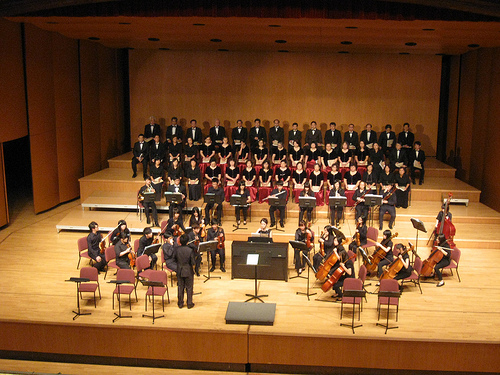
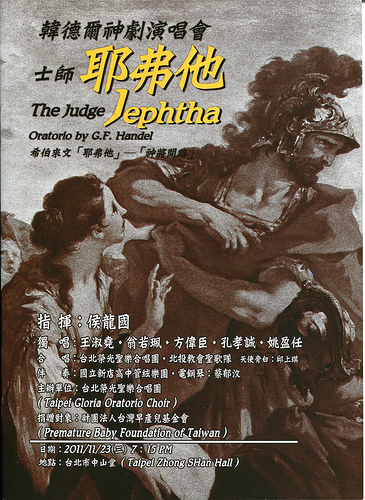
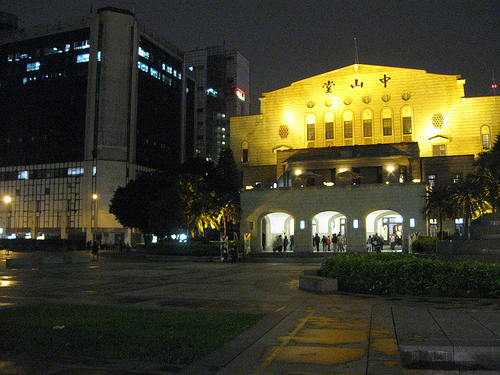
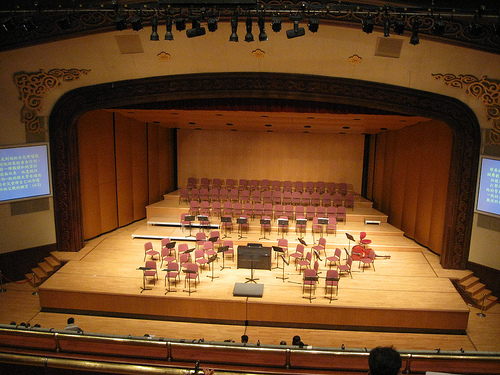
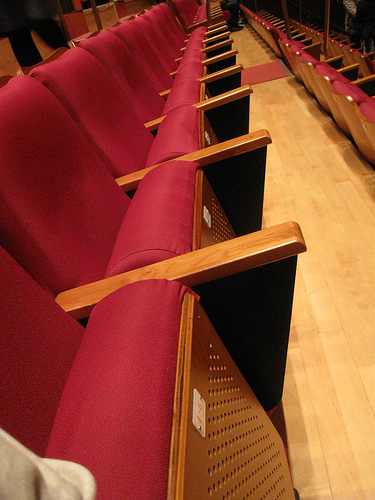
1. “Though other sources say it was the Taipei City Hall – in fact, the fourth largest city hall in all of Japan and its possessions at the time.” Really? It didn’t seem that big. What’s (was) the seating capacity?
2. “A quick glance told me that I was probably at the right place. No tattoos, bright blue hair, or fashionably cut jeans here.” On the other hand, the area directly in front of the hall is popular with skaters. I’ve seen lots of tattoos, hair and jeans there.
3. The balcony is the best place to sit. You can the other people better from this position.
These two quotes are from the official Zhongshan Hall website.
I’m still confused about the whole “Taipei City Hall” thing. It seems like it was designed to be a performance space – an auditorium/theater. I’m not sure how it could have served as a city hall. I’ll have to go back and check who used the term City Hall and what they meant by it.